Tianjin SightseeingVisit Tianjin's Landmarks and Immerse in Chinese CultureTianjin is a good choice as a travel destination. With its cool sea breeze and fresh sea air you will definitely feel refreshed. Historical relics, natural scenery, temples, churches, assembly halls and commemorative sites of the Chinese revolution will illuminate Tianjin's past, present and future. Tianjin is a famous historical city and a good choice as a travel destination. There are many scenic spots and historical sites, including the Dule Temple in Ji County, The Great Wall at the Huangya Pass, the Panshan scenery area. With its cool sea breeze and fresh sea air you will definitely feel refreshed. Tianjin is honored as a 'Building Museum' due to its occupation by the nine imperial powers before the founding of the new China, leaving behind many buildings with extraordinary and exotic architectural styles, a real feast for the eye!
The Huangyaguan Great Wall geographically belongs to Jixian County at the very northern tip of the Tianjin Municipality and is some 28 kilometers north of Jixian County Town. The pass, the only one of its kind in the County, contains the section of the Great Wall thatextends northward to Hebei Province. Even during the Qing Dynasty over two thousand ago, it was an important pass in northern China. In recent years, some new features have been added to the original construction, such as the Eight Diagrams Labyrinth (Bagua cheng), the Forest of Steles (Shike beilin), a museum (Bowuguan) and the Water Pass (Shui guan). The wall here has also been renovated recently, although its edges still show signs of decaying age. The most redeeming factor of this section is that it is less plagued by tourists than its Beijing counterparts. It is located in Jixian county 140 kilometers north of Tianjin.
As a large city, Tianjin can indulge you with almost all eight of the classical Chinese cuisines , of which seven types including Shandong, Jiangsu, Sichuan, Anhui, Guangdong, Zhejiang and Hunan Cuisines can be enjoyed in Food Street. Undoubtedly each cuisine is a feast for your pallet. What's more all the traditional Chinese constructions are also represented in this street making a feast for your eyes as well.
The gymnasium is 90.46 meters long and 48.46 meters wide inside with a floor space of over 5, 000 square meters. This multi-functional, international standard sport project has 10,000 seats in the main hall and 2,500 seats in its subordinate hall. The 43rd World Table Tennis Championship was held here in May 1995.
Zhonghuan is a beltway of Tianjin. High buildings, verdant trees, lovely flowers and parks are dotted along this beltway, which endows the whole city with a special glamour of modernity.
The Ancient Culture Street lies on the junction of three rivers and is the centre of ancient Tianjin. With a Mazu Temple in its center, it is the cradle of Tianjin's riverside culture. The Great Wall, running through Jixian County to the north of Tianjin also adds to the city's primitive simplicity and charm.
Situated next to the Hotel Street, the Clothing Street is the abbreviated name of the Tianjin Clothing Display and Sales Centre. Altogether there are over 100 shops in the Clothing Street which is operated by the state, collectives, or individuals. The stores offer famous, special and new clothes, in both retail and wholesale. |

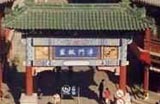 Jinmen Guli means old place in Tianjin for the
reason that Jinmen is another name for Tianjin and Guli implies
old place. Actually Jinmen Guli is a street on Gu Wehua Jie.
There are many stores along this street dealing in jade articles,
antiques, traditional handicrafts, especially famous Niren Zhang
painted sculptures and Weiji kites. What makes Gu Wenhua Jie
so amazing is that buildings on both sides of this street imitate
the architectural style of those in the Qing Dynasty (1644-1911)
Jinmen Guli means old place in Tianjin for the
reason that Jinmen is another name for Tianjin and Guli implies
old place. Actually Jinmen Guli is a street on Gu Wehua Jie.
There are many stores along this street dealing in jade articles,
antiques, traditional handicrafts, especially famous Niren Zhang
painted sculptures and Weiji kites. What makes Gu Wenhua Jie
so amazing is that buildings on both sides of this street imitate
the architectural style of those in the Qing Dynasty (1644-1911)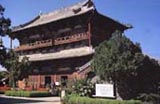 Dule Temple is more than 1,000 years old and consists
of a complex of grand structures. In Dule Temple you can see
the oldest multi-storied wooden pavilion in China and the Kwan-Yin
statue, one of the biggest clay sculptures preserved in China
Dule Temple is more than 1,000 years old and consists
of a complex of grand structures. In Dule Temple you can see
the oldest multi-storied wooden pavilion in China and the Kwan-Yin
statue, one of the biggest clay sculptures preserved in China Built in 1858 close to the sea, Dagu Emplacement was used to protect
the capital city of the Qing Dynasty, Beijing. If you ever visit
Dagu Emplacement, there are other attractions around worthy of
your time as well, such as Haimen Bridge and Dagu Beacon.
Built in 1858 close to the sea, Dagu Emplacement was used to protect
the capital city of the Qing Dynasty, Beijing. If you ever visit
Dagu Emplacement, there are other attractions around worthy of
your time as well, such as Haimen Bridge and Dagu Beacon.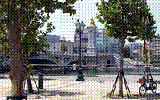 Like a beautiful painting, Haihe River makes Tianjin
City as charming as that seen in your imagination. In addition
Haihe River Park and Wanghailou Church enhance the river's beauty
a great deal. Strolling around the riverside at night adds to
the appeal and romance
Like a beautiful painting, Haihe River makes Tianjin
City as charming as that seen in your imagination. In addition
Haihe River Park and Wanghailou Church enhance the river's beauty
a great deal. Strolling around the riverside at night adds to
the appeal and romance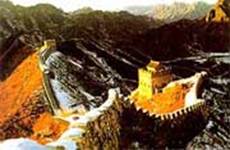 The
Huangyaguan Great Wall is an important military project of the
Northern Qi Dynasty (550-577) and is located at the juncture
of four cities, Beijing, Tianjin, Tangshan and Chengde and is
a wonderful example of ancient Chinese military engineering.
The
Huangyaguan Great Wall is an important military project of the
Northern Qi Dynasty (550-577) and is located at the juncture
of four cities, Beijing, Tianjin, Tangshan and Chengde and is
a wonderful example of ancient Chinese military engineering.  Panshan
Mountain is a very famous attraction in Tianjin. It is blessed
with strange rock formations, verdant trees, clear streams lakes
and mighty peaks. Panshan Mountain is made up of Shang Pan which
is famous for vigorous pine trees, Zhong Pan which is well-known
for unique rocks, and Xia Pan that is renowned for crystal clear
stream water
Panshan
Mountain is a very famous attraction in Tianjin. It is blessed
with strange rock formations, verdant trees, clear streams lakes
and mighty peaks. Panshan Mountain is made up of Shang Pan which
is famous for vigorous pine trees, Zhong Pan which is well-known
for unique rocks, and Xia Pan that is renowned for crystal clear
stream water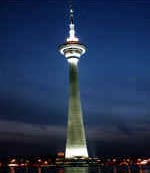 Tianjin
TV & Radio Tower is the fourth highest TV tower in the world
after Toronto TV Tower in Canada, Moscow Tower in Russia, and
Oriental Pearl TV Tower in Shanghai, China. It is located in Tianta
Lake, and looks like a sword thrusting into the sky. There is
a restaurant in the tower at the height of 248 meters (about 814
feet) to 278 meters (about 912 feet) which can simultaneously
accommodate more than 200 guests and providing a bird's eye view
of all Tianjin in this 'hanging restaurant'.
Tianjin
TV & Radio Tower is the fourth highest TV tower in the world
after Toronto TV Tower in Canada, Moscow Tower in Russia, and
Oriental Pearl TV Tower in Shanghai, China. It is located in Tianta
Lake, and looks like a sword thrusting into the sky. There is
a restaurant in the tower at the height of 248 meters (about 814
feet) to 278 meters (about 912 feet) which can simultaneously
accommodate more than 200 guests and providing a bird's eye view
of all Tianjin in this 'hanging restaurant'. More than half of the Water Park's area is covered
with water, which makes this park a lovely and special one.
In the park there are twelve small islands connected by arched
bridges and small mounds. Weeping willows along the waters edge
and lotus flowers in the water make this a relaxing place to
visit.
More than half of the Water Park's area is covered
with water, which makes this park a lovely and special one.
In the park there are twelve small islands connected by arched
bridges and small mounds. Weeping willows along the waters edge
and lotus flowers in the water make this a relaxing place to
visit. Covering an area of 111 hectares, the centre includes
a gymnasium, a stadium, an indoor swimming pool, bicycle racing
ring, base ball arena and athletes' village. In addition, there
is also a park for the public to do physical exercises and hold
various recreational activities.
Covering an area of 111 hectares, the centre includes
a gymnasium, a stadium, an indoor swimming pool, bicycle racing
ring, base ball arena and athletes' village. In addition, there
is also a park for the public to do physical exercises and hold
various recreational activities.
